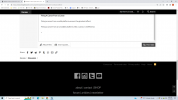Habib
Level 2 Valued Member
In deadlift dynamite(i read first edition) it outlines in the book to get your lats, abs and fists and tight as you possibly can on every lift you do in the weight room.
In the bench press, there is an idea of pulsing(where you get tighter at a certain time in the lift) and it instructs me to pulse by squeezing my fists and glutes harder and also driving my feet into the ground harder.
The bench press technique doesnt talk about tensing your abs and lats so would the technique be:
. Having abs, lats, fists and glutes squeezed maximally before deep breath into belly with thinly pursed lips and unracking.
. Then lowering bar and as soon as it touches your chest you pulse by squeezing lats, abs, grip and glutes harder(andy bolton said in a tightness article on this website that you should squeeze your grip harder when it touches your chest and said it is somehow possible to do this even when you have been maximally squeezing your grip before) and driving your feet into the ground your hardest to make the push upwards better.
. Also push with CAT(compensatory speed something) and breathe out through thinly pursed lips at the sticking point but leave air in your belly. Also flare elbows at the sticking point.
. Rack bar- also always stay tight under he wieght even when locked out
Questions:
. Was this good technique(my interpretation of the first edition book- cant get second edition but heard on the forum its the same but with a more streamlined explanation and look. Dont exactly know where from on the forum)
. Are you only allowed to breathe while pushing or can you breathe when locked out(i huff and puff for quite a bit after a few reps of practicing technique with a stick- i feel light headed mid set from only breathing while driving up)
. It always says the sticking point but what if there is no sticking point(no sticking point-means no struggling) do you flare elbows and breathe out in that instance. Or am i getting the definition of sticking point wrong and is sticking point the hardest part of the lift despite the difficulty of the lift- the middle
In the bench press, there is an idea of pulsing(where you get tighter at a certain time in the lift) and it instructs me to pulse by squeezing my fists and glutes harder and also driving my feet into the ground harder.
The bench press technique doesnt talk about tensing your abs and lats so would the technique be:
. Having abs, lats, fists and glutes squeezed maximally before deep breath into belly with thinly pursed lips and unracking.
. Then lowering bar and as soon as it touches your chest you pulse by squeezing lats, abs, grip and glutes harder(andy bolton said in a tightness article on this website that you should squeeze your grip harder when it touches your chest and said it is somehow possible to do this even when you have been maximally squeezing your grip before) and driving your feet into the ground your hardest to make the push upwards better.
. Also push with CAT(compensatory speed something) and breathe out through thinly pursed lips at the sticking point but leave air in your belly. Also flare elbows at the sticking point.
. Rack bar- also always stay tight under he wieght even when locked out
Questions:
. Was this good technique(my interpretation of the first edition book- cant get second edition but heard on the forum its the same but with a more streamlined explanation and look. Dont exactly know where from on the forum)
. Are you only allowed to breathe while pushing or can you breathe when locked out(i huff and puff for quite a bit after a few reps of practicing technique with a stick- i feel light headed mid set from only breathing while driving up)
. It always says the sticking point but what if there is no sticking point(no sticking point-means no struggling) do you flare elbows and breathe out in that instance. Or am i getting the definition of sticking point wrong and is sticking point the hardest part of the lift despite the difficulty of the lift- the middle



